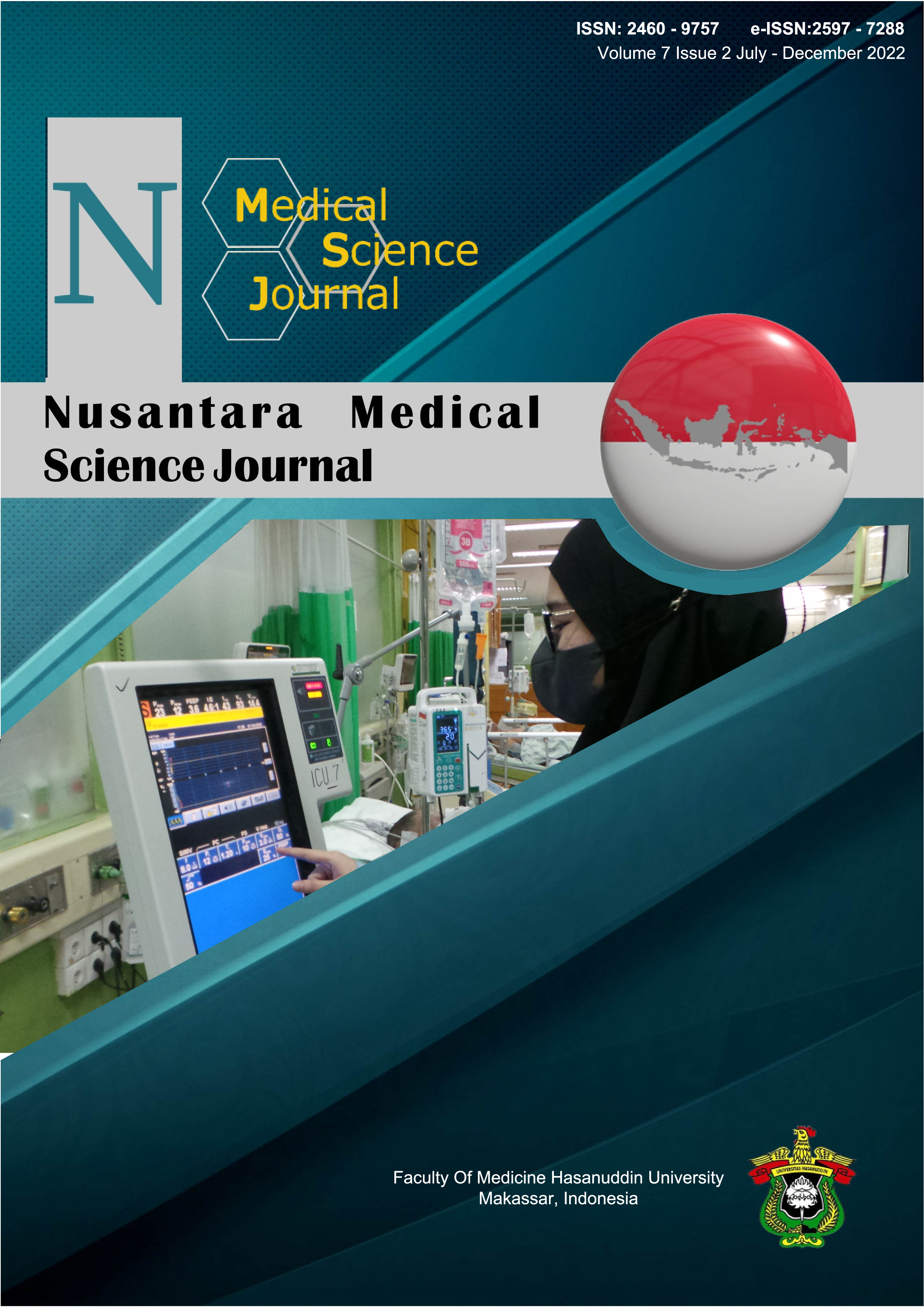The Relationship of Sociodemographic Factors with Near-miss and Missed Cases in Educational and Affiliated Hospitals in Makassar from 2019 to 2020
DOI:
https://doi.org/10.20956/nmsj.v7i2.19879Abstract
Introduction: Maternal mortality remains a critical issue in achieving optimal health status. Evaluation through near-miss cases provides valuable data about morbidity to monitor the quality of obstetric services, which can be used to estimate the incidence of life-threatening obstetric complications. A study reported that the incidence of near-miss in pregnant women had a significant relationship with various non-medical factors, included sociodemographic factors. Therefore, this study aims to examine the relationship of sociodemographic factors with near-miss and missed cases. Methods: This analytic retrospective study conducted in Educational and affiliated hospitals in Makassar. Data were retrieved from the obstetric referral registry from 2019 to 2020. Sociodemographic factors of interest include diagnosis, gestational age, maternal age, referral status, maternal parity, and economics. Results: A total of 156 near-miss and missed cases were obtained from January 1, 2019, to December 31, 2020. There was no significant relationship between maternal age (p=0.675), gestational age (p=0.38), parity (p=0.24), economic status (p=0.73), educational background (p=0.85), and referral status (p=0.16) with maternal near-miss and missed cases. Conclusions: There was no significant relationship between sociodemographic characteristics and maternal near-miss and missed cases in Educational and affiliated hospitals in Makassar from 2019 to 2020. More studies are needed to evaluate other factors associated with near-miss and missed cases.
References
Bappenas. Tujuan Pembangunan Berkelanjutan. Jakarta: Kementerian Perencanaan Pembangunan Nasional Republik Indonesia, 2021.
World Health Organization. Sexual and Reproductive Health. Maternal Mortality Level and Trends 2000 to 2017. September 21, 2021. Available: https://www.who.int/reproductivehealth/publications/maternal-mortality-2000- 2017/en/
Kementerian Kesehatan Republik Indonesia. Profil Kesehatan Indonesia 2020. Jakarta : Kementerian Kesehatan Republik Indonesia, 2020.
Dinas Kesehatan Provinsi Sulawesi Selatan. Profil Dinas Kesehatan Provinsi Sulawesi Selatan Tahun 2020. Makassar : Dinas Kesehatan Provinsi Sulawesi Selatan, 2020.
Adisasmita, Asri C. Near-missed Obstetric Sebagai Indikator Alternatif Outcome Kesehatan Ibu. Depok : Fakultas Kesehatan Masyarakat Universitas Indonesia, 2016. ISBN: 978-979-9394-41-5.
Oladapo, OT, et al. Near-missed cases and maternal death in Sagamu, Nigeria: a retrospective study. Sagamu : Reprod Health, 2016. 2:9.
World Health Organization. Beyond the numbers: reviewing maternal deaths and complications to make pregnancy safer. Geneva : WHO, 2016.
Roopa, PS, et al. Near-missed Obstetric Cases and Maternal Deaths in a Tertiary Care Hospital: An Audit. s.l. : Journal of Pregnancy, 2018.
Determinan Kejadian Maternal Near-missed di Indonesia (Analsis Data Sekunder SDKI 2007). Setia, Sindu, Mutahar, Rini and Destriatania, Suci. Palembang : Jurnal Ilmu Kesehatan Masyarakat, 2018, Vol. 4.
Sosial, Divisi Obstetri Ginekologi. Registrasi Tahunan Kasus Rujukan Obstetri dan Ginekologi di Beberapa RS di Kota Makassar Periode tahun 2019-2020. s.l. : Departemen Obstetri Ginekologi Universitas Hasanuddin, 2021.
Abdulmuthallib. Kelainan hematologik. [book auth.] Saifuddin AB. Ilmu kebidanan sarwono prawirohardjo. Jakarta: PT Bina Pustaka Sarwono Prawirohardjo, 2016.
Faktor yang memengaruhi kematian ibu (studi kasus di kota surabaya). Jayanti, Dwi Krisnita, Basuki, Hari and Wibowo, Arief. 1, Surabaya : Jurnal Wiyata, 2018, Vol. 3.
Faktor-faktor yang Berhubungan dengan Kejadian Kematian Maternal di Solo raya (Studi Kasus di RSUD Dr. Moewardi Surakarta). M, Pratama. Surakarta : Universitas Muhammadiyah Surakarta, 2016.
Maternal Near-missed In A Rural Hospital In Sudah. Abdelaziem, Ali. Sudan : Biomed Central, 2019.
Maternal Near-missed and Maternal Death in The World Health Organization's. Souza, JP. s.l. : Global Survey on Maternal and Perinatal Health, 2015.
Faktor-faktor yang mempengaruhi terjadinya kematian maternal dan nyaris mati maternal di RSUD Dr. Pringadi Medan tahun 2007. Napoleon, Jhon. Medan : Repository USU, 2018.
Obstetri William's. Gary, Cunningham F. Jakarta : EGC, 2017.
Factors associated with underutilization of antenatal care services in Indonesia: results of Indonesia Demographic and Health Survey. Titaley, Christiana, Dibley, Michael and Roberts, Christine. 1, s.l. : BMC Public Health, 2016, Vol. 10.
Factors associated with the use and quality of antenatal care in Nepal: a population-based study using the demographic and health survey data. Joshi, Chandni, et al. 1, s.l. : BMC Pregnancy and Childbirth, 2016, Vol. 141.
Downloads
Published
How to Cite
Issue
Section
License
Copyright (c) 2022 Nusantara Medical Science Journal

This work is licensed under a Creative Commons Attribution 4.0 International License.









